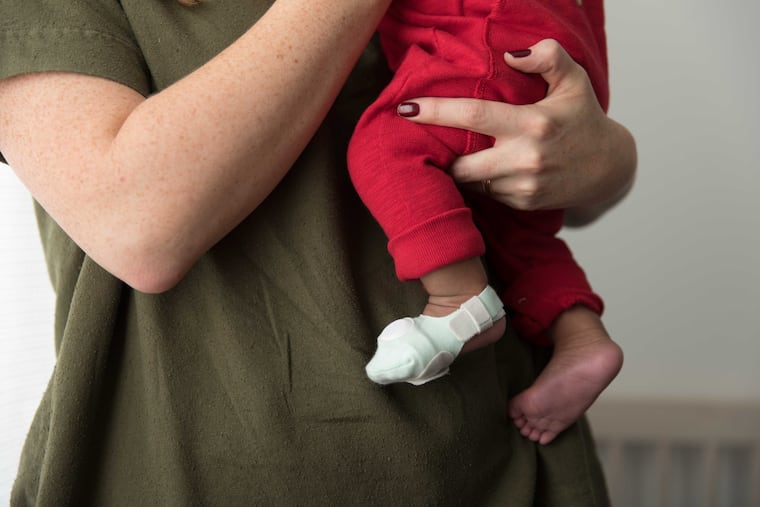Why that wearable baby monitor could do your child more harm than good

Pediatrician Christopher Bonafide remembers how he learned about the latest high-tech helper for anxious new parents.
An infant had been admitted to Children's Hospital of Philadelphia because the mother said his home apnea monitor kept going off. Doctors told her to bring the device in so they could review its data on the infant's breathing interruptions.
"We were all assuming it was a hospital-grade apnea monitor," Bonafide recalled. "The mom opens up her purse and pulls out this diaper clip. She bought it online after a friend recommended it. The baby was fine."
That was three years ago, the beginning of a booming — and basically unregulated — market for wearable baby monitors that cost $300 or less. Sensors are built into socks, onesies, buttons, leg bands, or clip-ons to track physical signs such as heart rate, breathing, temperature, blood oxygen level, sleeping position. If something seems amiss, an alarm is sent wirelessly to parents' smartphones.
But now, critics are sounding alarms.
In this week's Journal of the American Medical Association, Bonafide joined with Children's Hospital pediatrician Elizabeth Foglia and David Jamison, a medical-device evaluator at the nonprofit ECRI Institute in Plymouth Meeting, to warn that these gadgets are not checked by the Food and Drug Administration for safety, effectiveness, or even accuracy. Parents seeking peace of mind may get just the opposite, and their healthy babies may wind up in a doctor's office or emergency room for harmless fluctuations in vital signs, or erroneous readings.
"There is no evidence that consumer infant physiologic monitors are life-saving, and there is potential for harm if parents choose to use them," the authors conclude in their viewpoint article.
Owlet, a leading manufacturer based in Utah, emailed a defense of its $250 "smart sock" monitor: "We have invested millions of dollars into data collection, as well as the creation of a clinical team ... to further knowledge of the issues affecting infant health. With more than 80,000 families using the product, we are confident in the positive results these families are experiencing."
You don't have to be a helicopter parent to like the idea of remote surveillance of the nursery; that's why old-fangled audio and video monitors remain popular.
But the viewpoint authors say that monitoring a baby's vital signs, sensible as that may sound, poses problems.
According to the American Academy of Pediatrics, even FDA-approved cardiorespiratory monitors — the kind doctors prescribe for use at home to detect apnea or abnormally low heart rates — have not been shown to save babies from dying suddenly in their cribs. What's more, routine in-hospital monitoring hasn't been shown to detect which infants are at risk of sudden infant death syndrome (SIDS) when they go home.
"Do not use home cardiorespiratory monitors as a strategy to reduce SIDS," the academy bluntly says in recommendations, updated last year, for keeping infants safe during sleep.
Another problem is that mobile medical apps don't have to undergo FDA review — at least, not yet. Nearly two years ago, the agency said it intended to require app manufacturers to meet certain safety standards if they claim their products have medical purposes — meaning the devices diagnose, treat, or prevent a disease.
But Owlet, MonBaby, Baby Vida, Snuza, Sproutling, and other baby sensor makers carefully avoid making such explicit claims.
"Get more sleep and stress far less with Snuza's portable baby movement monitors," says the Snuza website. "We have a vested interest in your child's safety."
"Glancing at a traditional monitor doesn't give you the whole story of your baby's well-being," the Owlet website says, adding that its smart sock isn't just an accessory, "it's a necessity."
"We're letting companies make a lot of money by making an end run around the FDA," said Jamison at ECRI, which plans to evaluate wearable baby sensors this year. "It looks and smells like a medical device, but we're not going to call it that."
Others worry that wearable technology can be connected to the internet, creating concerns about patient privacy and security.
In online reviews and forums, new parents tell why they want high-tech guardian angels — and they share some pitfalls.
"My 9-month-old recently started sleeping on her belly with her face down. I know she is strong enough but I still wanted something to reassure me she was still breathing," wrote the buyer of a $99 MonBaby Smart Button. "I thought this would be perfect! We got everything working on the first night. Then we went to our bedroom which was across the hall. It kept disconnecting. It would not work at all. The manual states that wall interference may occur."
The viewpoint authors acknowledge that the fast-evolving world of wearable monitors is innovative and could improve the care of infants with cardiorespiratory problems, "but only if the safety, accuracy, and effectiveness are demonstrated."
"I think parents have always been concerned and worried and want to do the best they can," Bonafide said in an interview. "What has changed is the availability of technology and data. Companies are taking advantage of parental anxiety. In my opinion, these devices are not the way to alleviate that anxiety."